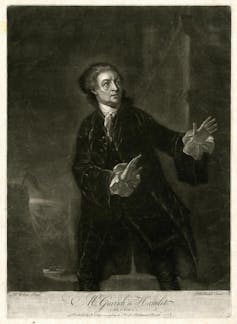Art and Culture
Theatre audience etiquette and norms have always shifted with the times

Face masks, plexiglass dividers, proof of vaccine and photo ID and strict seating assignments: This might not sound like your ideal night out at the theatre. But as performance venues across the country begin raising the curtain once more, such regulations will likely become part of the “new normal.”
While many of these rules may appear unprecedented, COVID-19 protocols can be connected to a long history of regulating audience behaviours in theatres. In the approximately 2,500 years of western theatre history, rules and expectations of theatre audiences have reflected the ways that societies negotiate behavioural and social norms. Audience conduct has frequently raised questions about how spectators should behave and who should oversee that behaviour.
Audience fines playwright
Take, for example, ancient Greek theatre. Audiences in the theatre of ancient Greece were active and vocal participants in the many dramatic festivals. Aristotle describes an angry audience shutting down a performance after they perceived inconsistency in the staging.
Classics scholar David Kawalko Roselli describes a story from ancient historian Herodotus: Spectators of Phrynichus’s The Sack of Miletus burst into tears and assigned the playwright a fine of 1,000 drachmas due to the play’s upsetting content.
Alongside this lively conduct was also an impulse to regulate audience behaviour: Roswelli describes a kind of “theatre police” tasked with maintaining order during performances.
Pick-pocket tied to pillar
Renaissance England was renowned for its boisterous audiences who, in public outdoor theatres, might urinate, engage in romantic trysts, sleep, eat and drink heartily all while taking in Shakespeare’s newest work.
Many of these theatres avoided regulation from authorities by being located outside of the City of London, alongside bear-baiting arenas, pubs and sex workers in the so-called red-light district of Southwark.
Shakespeare scholar Andrew Gurr writes that given this lack of oversight, the audience set the rules: someone caught pick-pocketing might be tied to one of the stage pillars as punishment, for example.
Cancelling cheap seats

In the mid-18th century, celebrated performer and theatre manager David Garrick was determined to reform the audience behaviour he saw as disruptive. Up to this point, audience members could actually sit on stage alongside the performers.
One satirical text called The Gull’s Hornbook even gave advice on how best a spectator may draw attention to themselves and away from the entertainment at hand — by showing off one’s legs, clothing, hair and “tolerable beard.”
Garrick renovated his theatre to move the audience off stage, and prevent them from entering the theatre via the actors’ dressing rooms.
Garrick also attempted to do away with the selling of half-price tickets at intermission. Under this system, spectators could pay cheaper tickets to only watch the second half of the show. He eventually backed down after audiences staged large riots, protesting the proposed change.
Lighting to divide
The 19th century brought about the popularization of the proscenium arch: an architectural feature that effectively separates the audience from the actors on stage by way of a picture-frame-like border around the stage. Alongside this structural shift, a change in lighting also reinforced the separation between audience and performers.
Up until the 19th-century, the seating area would be as brightly lit as the stage. In 1817 theatres began using gas lighting, and in 1837 limelight — which gets its name from calcium oxide, also known as quick lime — was introduced. These innovations placed the audience in shadow and illuminated the stage actors.
The audience — now physically separate and visually obscured — was more docile. As theatre scholar Caroline Heim describes, in the late 19th century, “rules admonishing expressive performance” by audience members were enforced. “In theatres, these were printed in playbills, on placards, hand-bills, notices on the backs of seats and outlined in lectures by theatre managers before performances.” By the end of the century, such expectations characterized a new behavioural “contract” audience members had to follow.
Cellphone frustration
Today, the notion of proper audience etiquette at the theatre persists. Audience etiquette guides, which cover everything from dress code, to late arrivals, to coughing and unwrapping candies, are widely available today.
Cellphone use has also become a particularly contentious audience behaviour, sometimes policed by the actors themselves: In 2015, American actress Patti Lupone halted a New York City performance by physically confiscating an audience member’s phone.
‘Relaxed performance’
Recently, activists, artists or scholars like Kirsty Sedgman have challenged audience etiquette guidelines as being exclusionary and needlessly restrictive. For example, ableist behaviour norms are being applied if people with motor or vocal tics find themselves unwelcome in spaces that require quiet, still audience members.
This pushback has helped popularize interventions like relaxed performances, which aim to make theatre more accessible by “relaxing” or easing behavioural expectations.
What it means to be together in public
Expectations around audience behaviour have continually shifted throughout Western theatre history. Attending the theatre has always provoked broader questions about what it means to be together in public. It is often the case that the norms in place at the theatre reflect — and sometimes even influence — larger social and technological norms.
So, while COVID-19 health and safety protocols could potentially be interpreted as restrictive, they, in fact, remind us that attending the theatre has often meant negotiating individual conduct and collective experiences or expectations.
And, importantly, unlike using your cellphone or unwrapping a candy, health and safety are essential for keeping theatre accessible and open to as many people as possible.
Kelsey Jacobson, Assistant Professor, Dan School of Drama and Music, Queen’s University, Ontario and Kelsey Blair, Assistant Professor, Department of English, Concordia University
This article is republished from The Conversation under a Creative Commons license. Read the original article.





















